Boring, dividend-paying stocks have been the way to go so far in 2022.
With the stock market being roiled by numerous outside forces — from inflation to the COVID-19 pandemic to supply-chain issues to Russia’s attack on Ukraine to rising interest rates — value has replaced growth as this year’s more successful investing strategy to date.
And when we talk about buying value, we’re so often talking about Dividend Growth Investing.
I need look no further than my Growth & Income Portfolio, which through April was running in negative territory in ’22. The culprit? Its tilt toward growth. (The GIP’s market value actually was about $150 higher on April 30 than it was on Dec. 31, but only because I invested around $400 in new money during the 4-month period.)
The portfolio owns pieces of 18 companies, and through April only three had total returns better than 2% this year: utility Sempra Energy (SRE), up 23%; bomb-maker Lockheed Martin (LMT), with a 22% return; and health-care conglomerate Johnson & Johnson (JNJ), ahead by 6%. Not coincidentally, all three of those market-crushing performers also have dividend yields of 2.5% or higher.
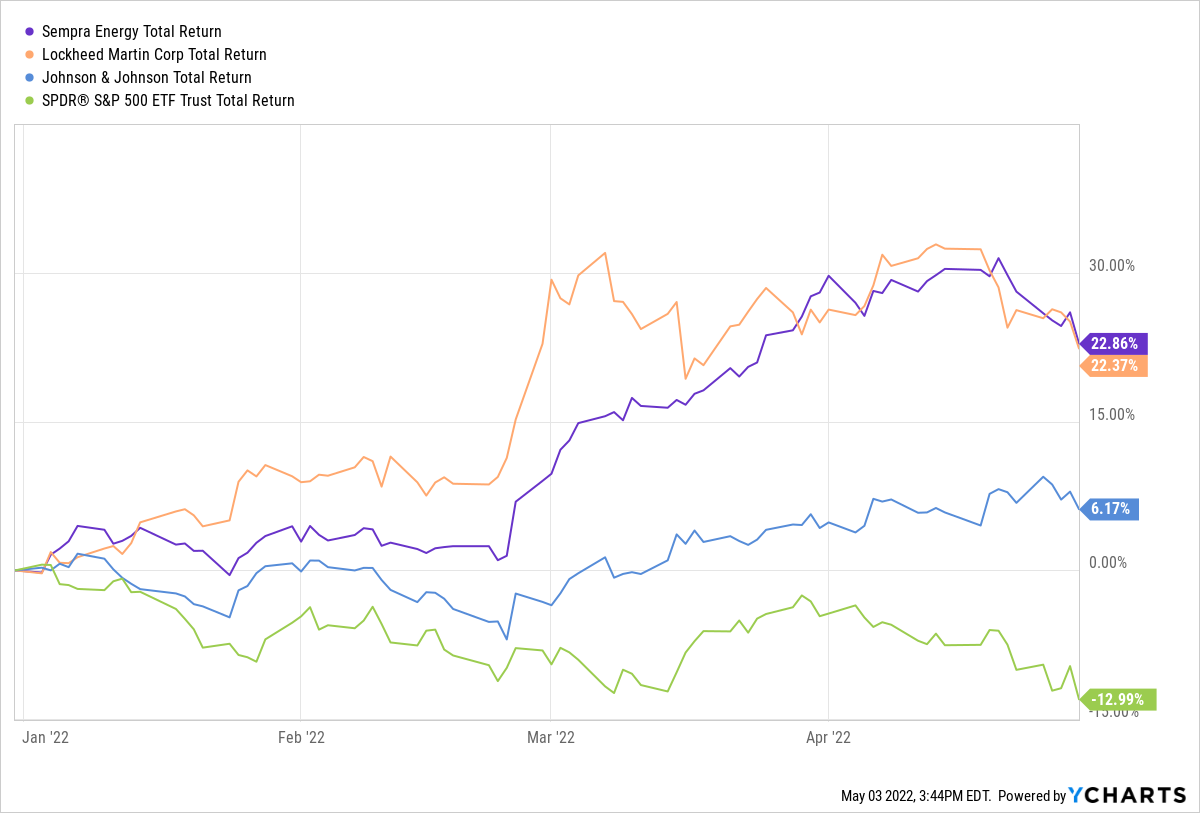
In the next tier of GIP positions are eight stocks that haven’t exactly been stellar performers but have at least beaten the market (as represented in these three YCharts by the SPDR S&P 500 Trust ETF).
This group includes Pepsi (PEP) and McDonald’s (MCD) — two companies with 40+ year dividend-growth streaks and yields of at least 2.25% — as well as five that have been increasing their annual dividends for a decade or more: UnitedHealth Group (UNH), Mastercard (MA), Costco (COST), Texas Instruments (TXN) and Apple (AAPL).
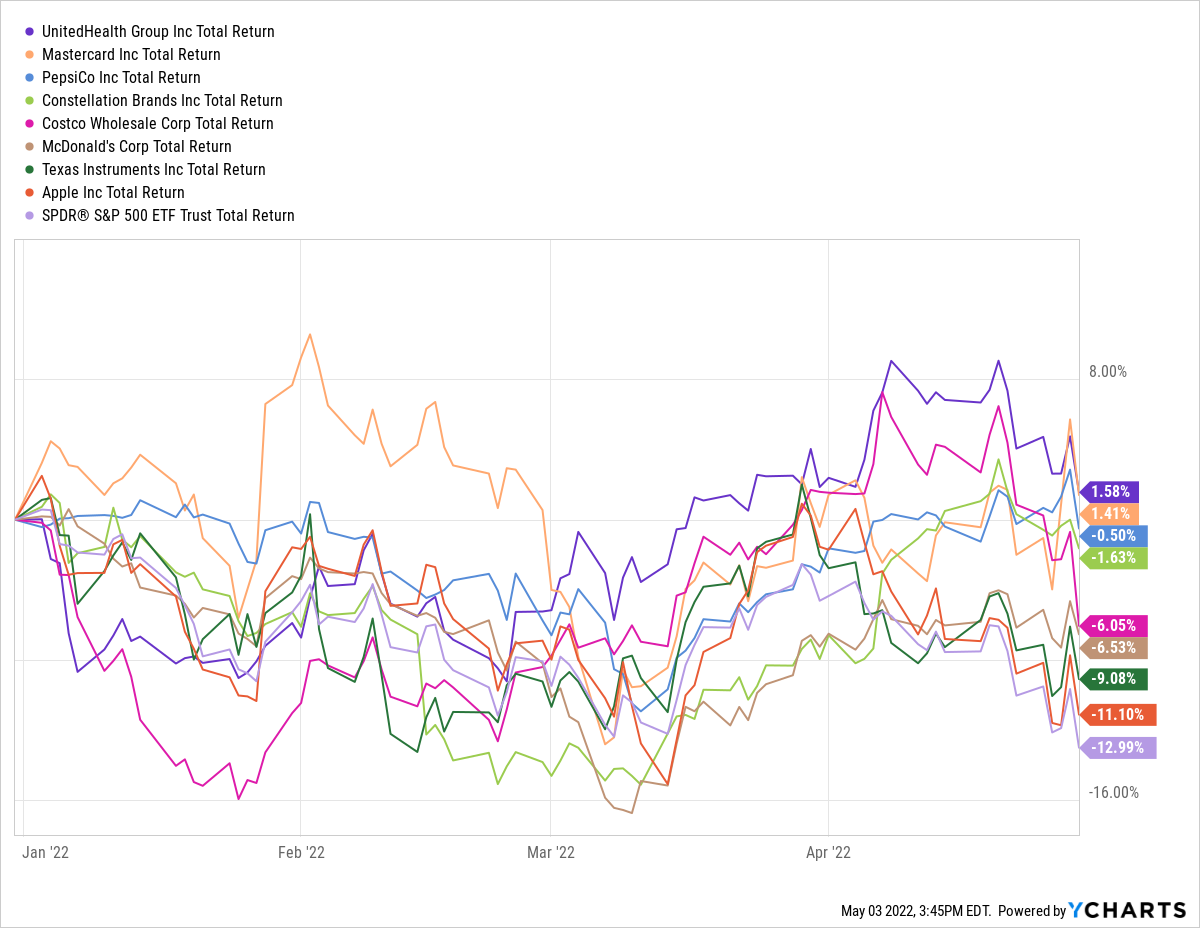
And then there are the seven GIP holdings that spent the first four months of 2022 sinking so far that they weren’t even able to match the market’s 13% loss. All are growth companies that have microscopic yields or — in the case of Alphabet (GOOGL), Amazon (AMZN) and DraftKings (DKNG) — pay no dividends at all.
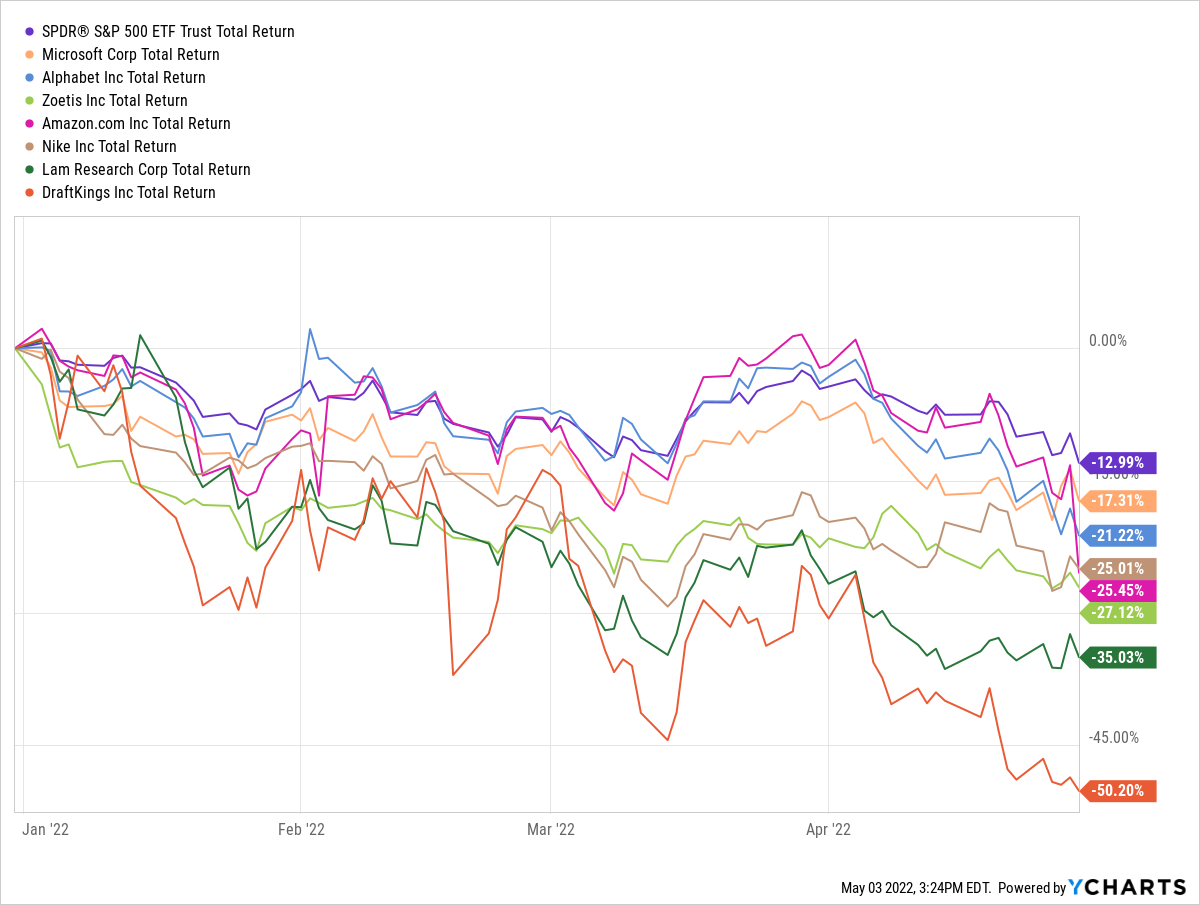
So am I abandoning the growth aspect of the portfolio? Not at all!
The Growth & Income Portfolio was launched in June 2020 as a way for me and my wife to eventually help pay for the college expenses of our now 2 1/2-year-old grand-twins, Logan and Jack. (It was originally called the Grand-Twins College Fund before undergoing a name change last September.)

That means we’ll be investing on their behalf for at least another 16 years before the money starts to get distributed.
I’m a DGI guy at heart, so I appreciate dividends more than most investors do. But when we’re talking about that kind of time horizon, I believe a portfolio should have solid growth names, too.
With that in mind, our $100 contribution for April was divided between two parts Amazon and one part each Lockheed Martin and McDonald’s — $50 into one of the largest and historically growthiest companies out there, and $25 apiece into two proven performers that have been raising their dividends for decades.
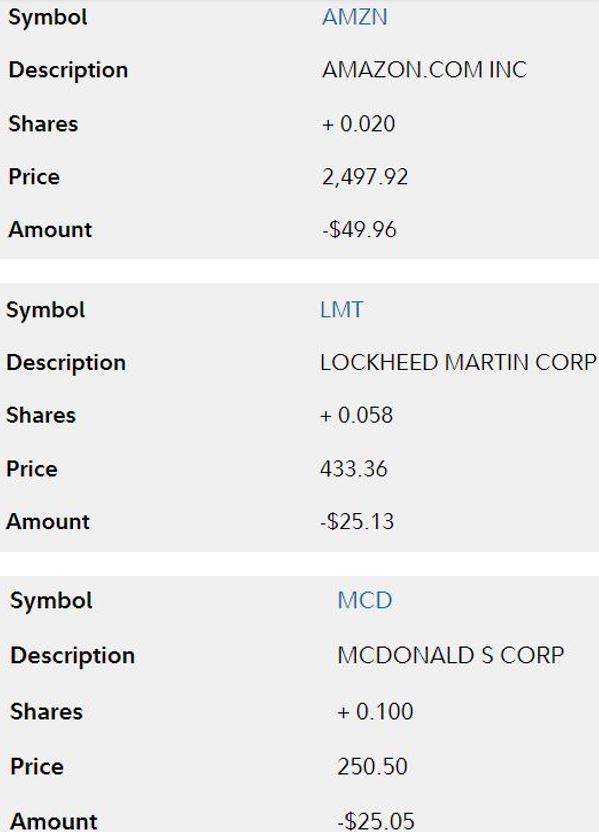
Zoning in on Amazon
I also manage the Income Builder Portfolio for this site. And in my most recent IBP piece, I talked about Amazon’s 14% decline on April 29 after an earnings report that had investors scrambling for the exit.
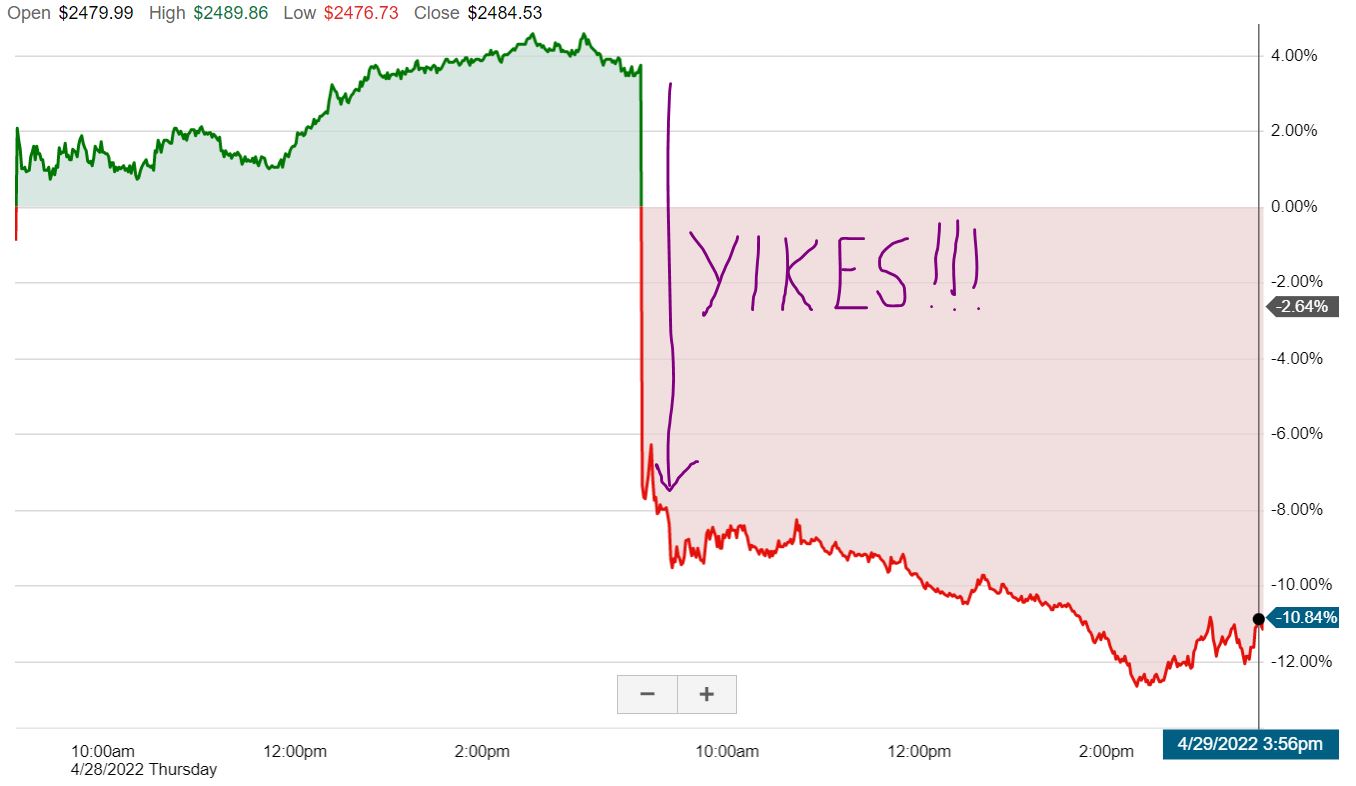
And yet here I am, adding to the Amazon position in the Growth & Income Portfolio. Why? Because I still believe that, long-term, AMZN will be a big winner. I also think it’s a better value now that the 14% decline is in the rearview mirror.
As Morningstar said:
Amazon is the clear leader in e-commerce and enjoys unrivaled scale to continue to invest in growth opportunities and drive the very best customer experience.
Analysts agree. Although one analytical firm after another lowered its 12-month target price after the earnings report, most reiterated a “buy” or “outperform” rating on the stock. Even the lowest adjusted price target — $3,125 from D.A. Davidson — was about 25% higher than the $2,498 we paid for our last little slice of AMZN.
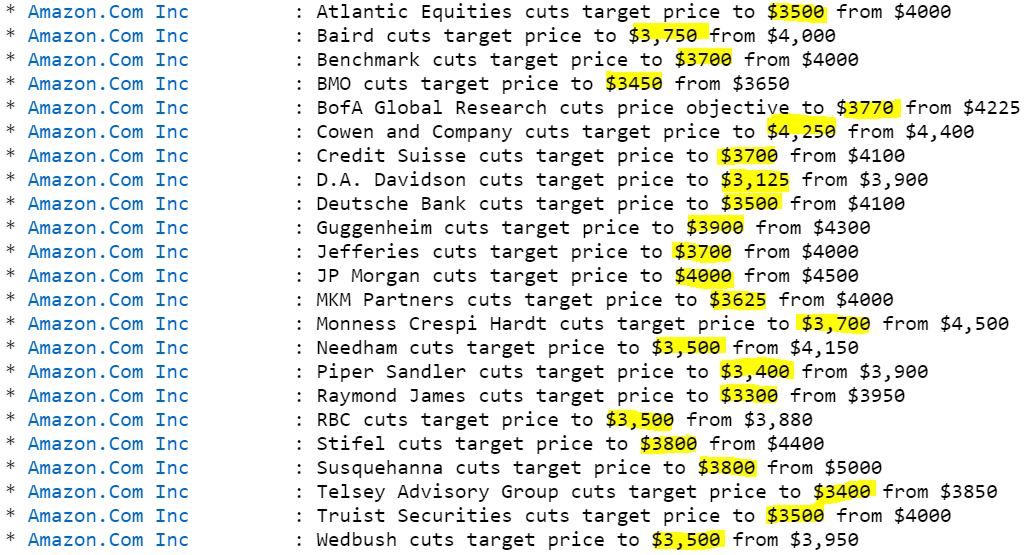
Morningstar, another analytical service, cut its fair value estimate from $4,100 to $3,850, but still calls AMZN a 4-star value thanks to its dominance in cloud services and its continued ability to steal business from both brick-and-mortar retailers and e-commerce competitors.
And even as Morgan Stanley reduced its price target from $4,200 to $3,800, it named Amazon one of its 45 “highest-conviction stock picks.”
The Other Buys
Lockheed Martin, a laggard for much of 2021, has been one of the Growth & Income Portfolio’s top performers so far this year with a market-thrashing 22% total return through April.
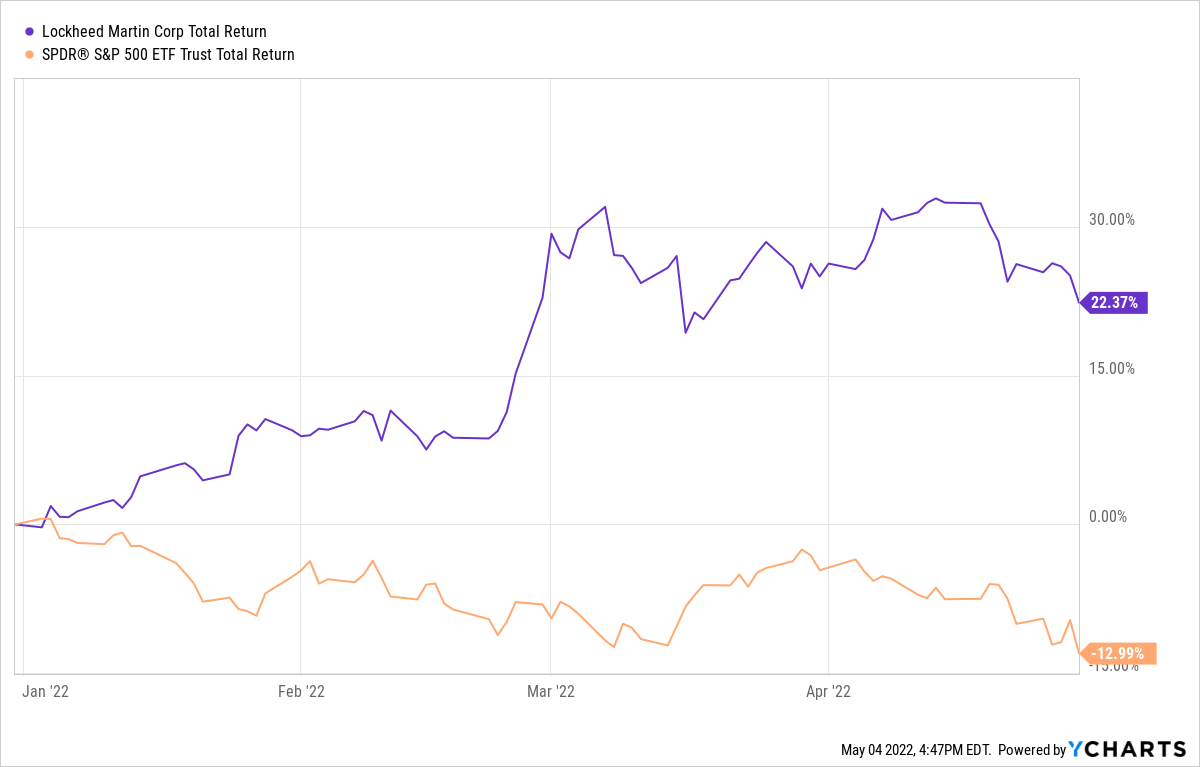
Some of that return was attributable to LMT being too good a value to stay down for very long, some was because the Pentagon received record funding from Congress, and some was because global conflicts tend to lift up prices of defense stocks.
McDonald’s hasn’t fared as well recently, down 6.5% this year through April, but it’s an all-weather Dividend Aristocrat that has tripled the market’s total return over the last 20 years.
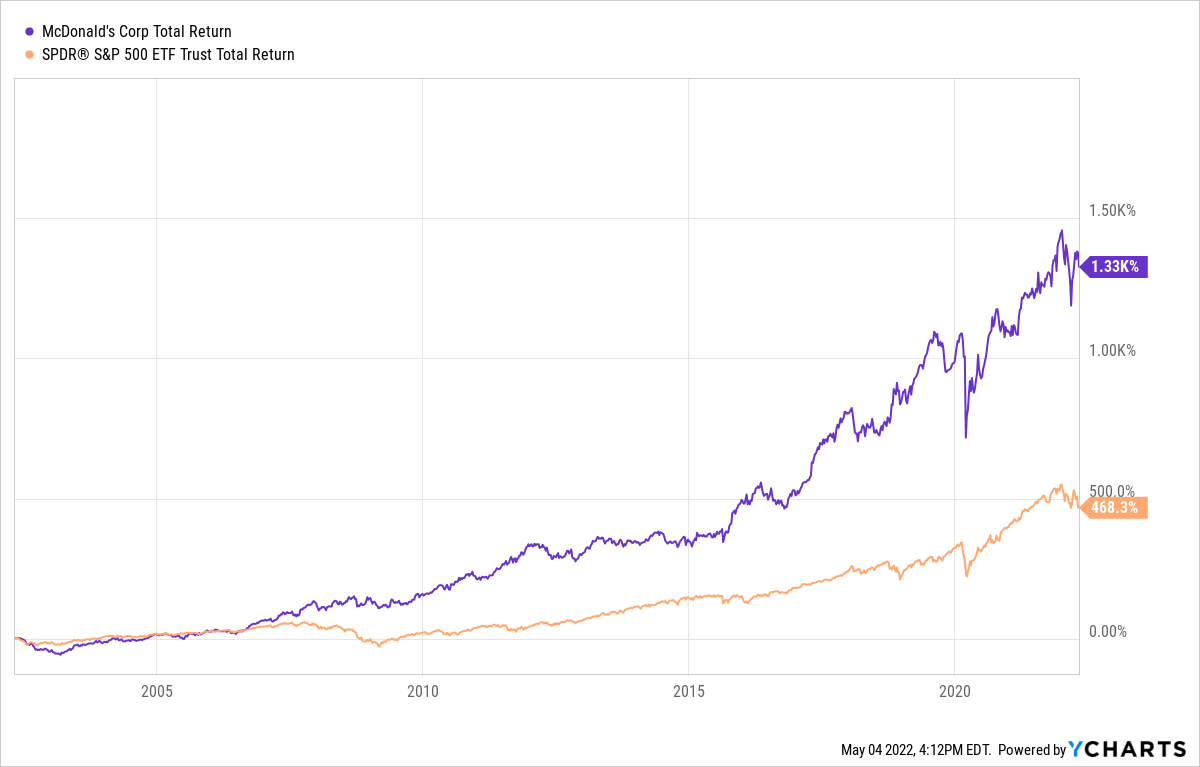
Also, I hadn’t bought any MCD for the GIP since September or any LMT since August, so it was simply time to add to both.
For those who regularly invest relatively small amounts of money — as is the case with so many of us — I think it’s important to just keep doing so regardless of the condition of the market. Over time, the market goes up.
And of course, Lockheed and McDonald’s — as well as Amazon — are very high-quality companies.

GIP April Update
We didn’t put any new money into 15 of the portfolio’s 18 positions during April, so I can make accurate month-over-month comparisons on those 15.
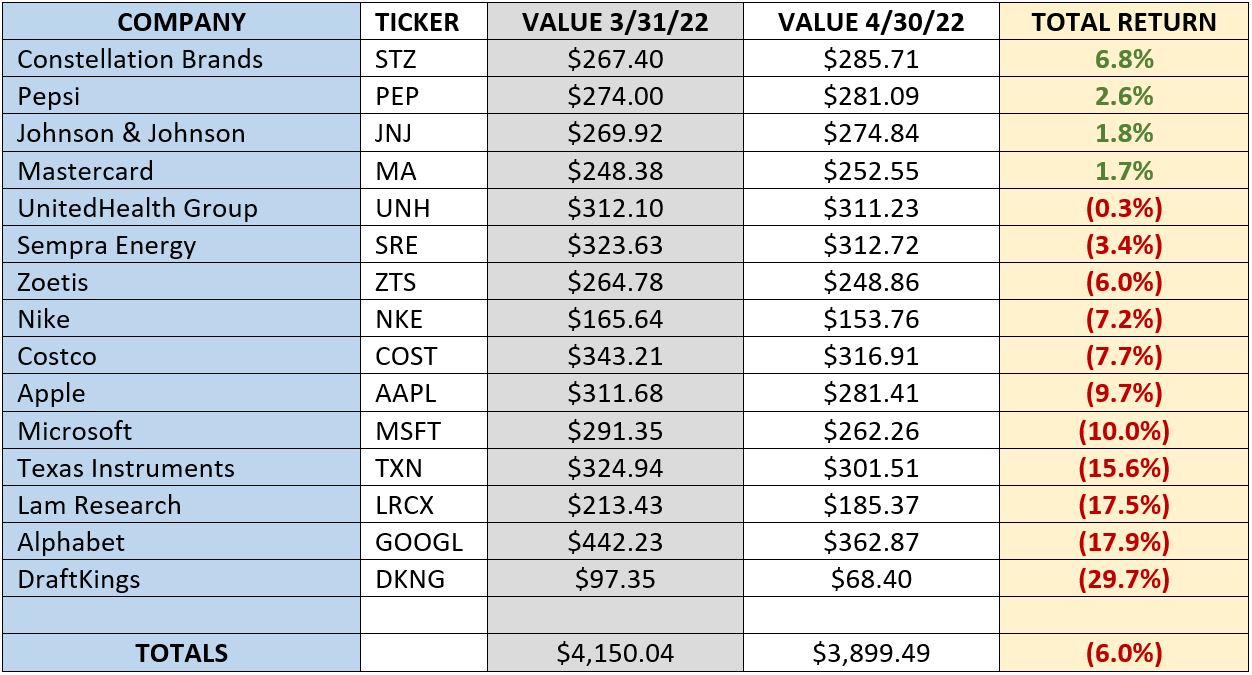
The results weren’t pretty. But remember that the S&P 500 Index lost 8.8% during the month and the Nasdaq lost 13.3%. So relatively speaking, it was … um … a good month for the GIP?
Constellation Brands (STZ), one of the world’s top booze sellers, bucked the trend to have an awesome April. It beat earnings estimates; it met consensus 2023 guidance; it abandoned what would have been a risky, expensive pursuit of Monster Beverage (MNST); and it raised its dividend 5.3%. Here’s to you, Constellation!

DraftKings, the gambling company that was one of the portfolio’s top performers in the months following our June 2020 purchase of it, exemplifies the rough times that growth companies — especially newer firms that aren’t turning profits yet — have experienced lately.
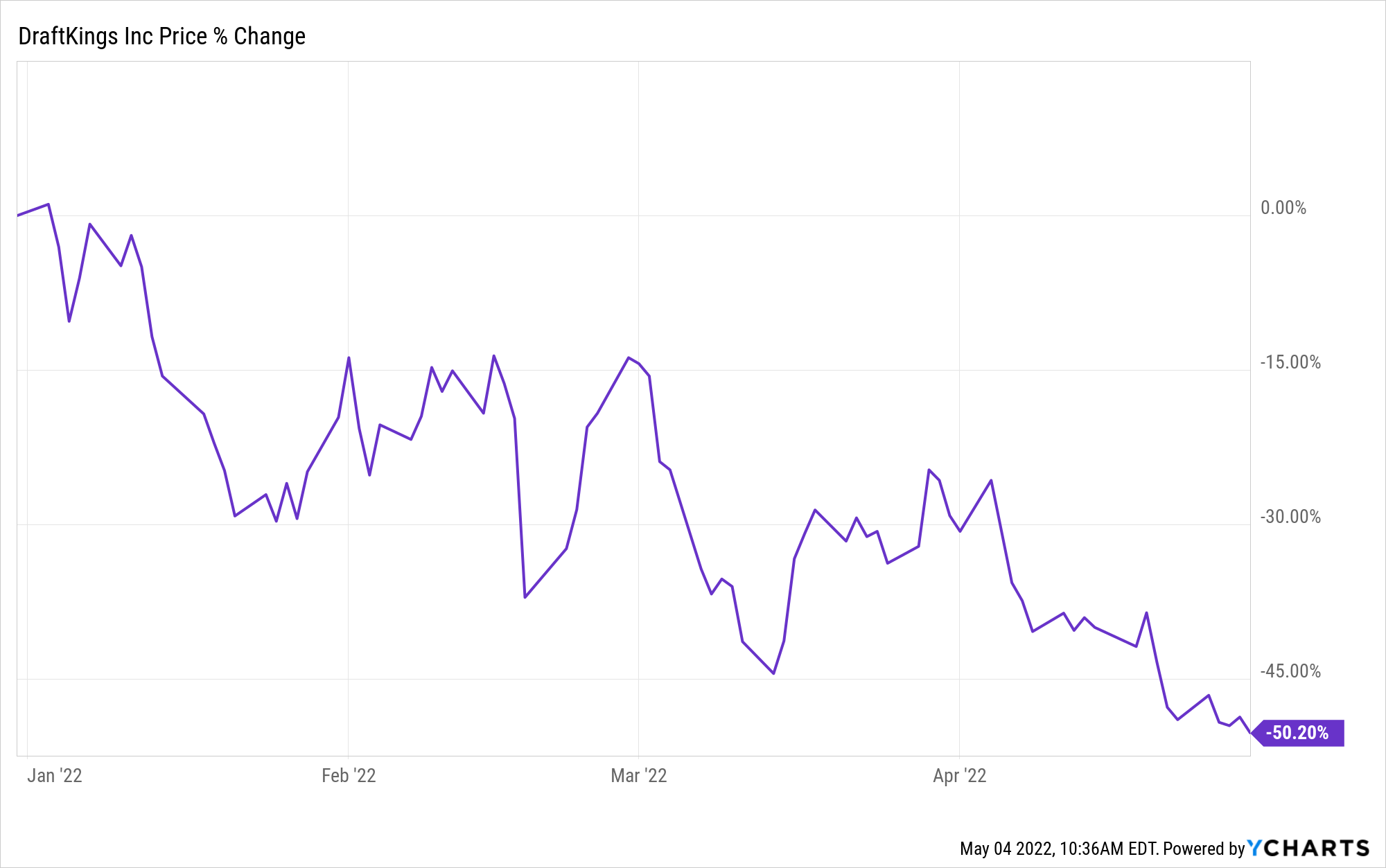
Maybe I’m just being stubborn, but I still think DKNG can be a good growth story once the company matures and can spend less on advertising and promotions, so I’m going to remain patient with it.
Income Report
Four Growth & Income Portfolio holdings announced dividend increases during April: Costco, Johnson & Johnson, Constellation and Apple.

One thing I really like seeing is that three of the four had better raises this time than they did a year ago — a positive trend.
Apple’s 4.5% hike was a little disappointing … but then again, I view Apple as a growth company and its dividend as more of a bonus.
Through April, the portfolio’s projected annual income was $65. That’s a small number for sure, but I believe dividends will be a meaningful part of the GIP a decade and more from now.
More Grandkids, More Buys
Last month I introduced the newest member of our family — granddaughter Piper, who was born in March. We started investing for big brother Owen last year, and now we’re investing for both of them.

In April, we bought another $100 worth of Toronto-Dominion Bank (TD), to go along with the hundreds of dollars we already had invested in Bank of Nova Scotia (BNS) on their behalf.
BNS sent its first dividend into the portfolio during April, and that was automatically reinvested to buy another fraction of a share. (Check out the videos that I made on both Canadian banks — TD HERE, and BNS HERE.)
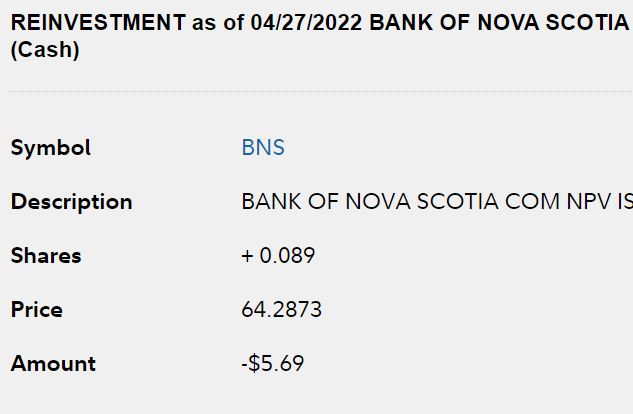
Wrapping Things Up
Although I do have some growthier names in my personal portfolio, they make up a very small percentage of it, as I mostly follow the Dividend Growth Investing strategy.
Given the stock market’s performance so far in 2022, it’s been comforting to own boring, “DGI-type” companies such as Chevron (CVX), Altria (MO), Merck (MRK), General Dynamics (GD) and Southern (SO).
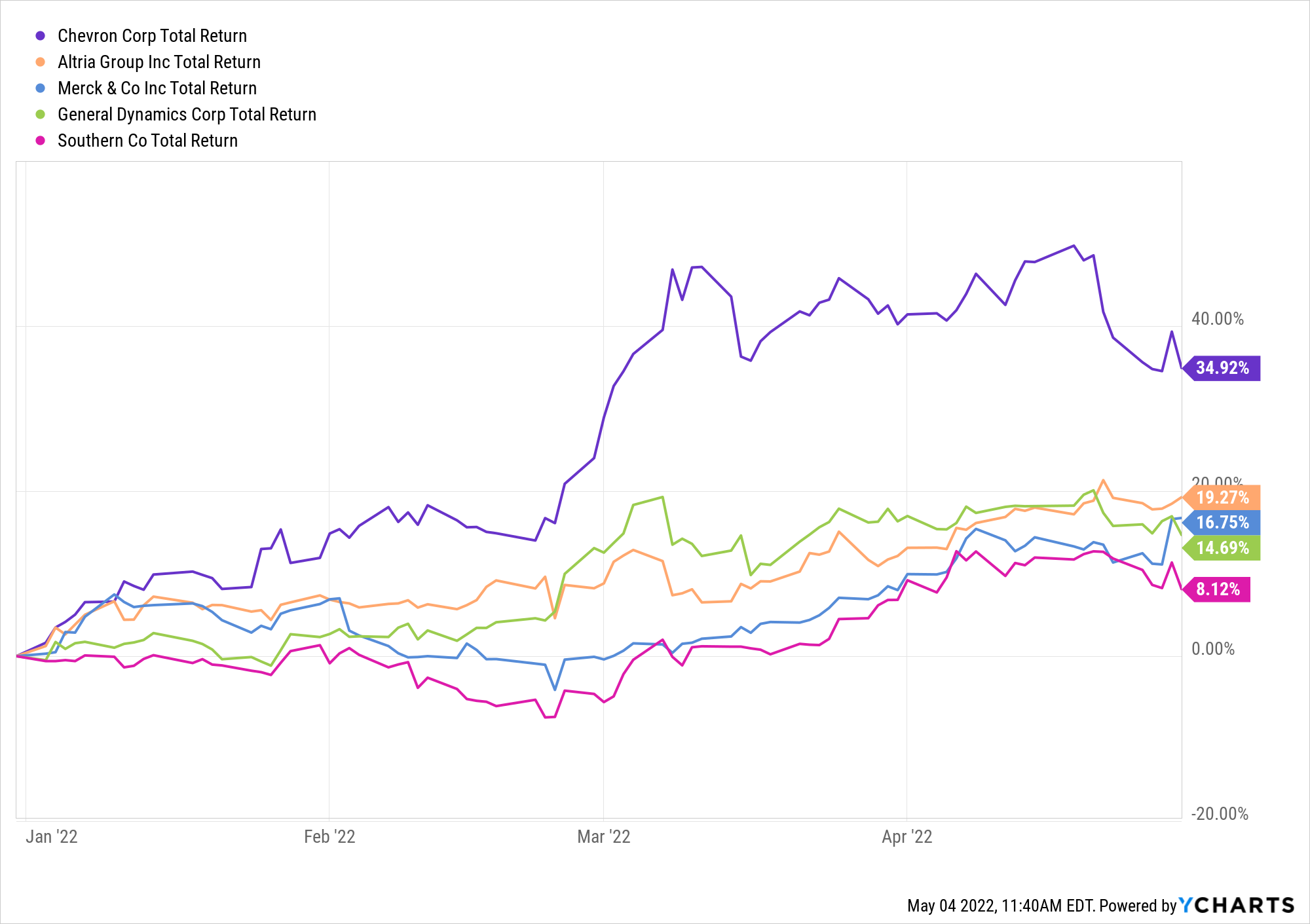
(The Income Builder Portfolio holds some of the same names; check out our IBP home page — HERE.)
Sure, those and other dividend-growing companies occasionally can and do have their issues. But you can’t grow dividends for decades without being fundamentally strong companies. And even when such stocks do suffer price declines, they still pay me back every quarter while I wait for upticks.
Having said all that, I’m also glad to have more of a growth tilt in the portfolio we’re building for our grandkids. They’re about 60 years younger than we are, and the goals of our portfolios are — and should be — different.
Investors are strongly encouraged to conduct their own thorough due diligence before buying any stocks.
— Mike Nadel
We’re Putting $2,000 / Month into These StocksThe goal? To build a reliable, growing income stream by making regular investments in high-quality dividend-paying companies. Click here to access our Income Builder Portfolio and see what we’re buying this month.
Source: DividendsAndIncome.com
